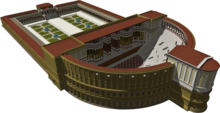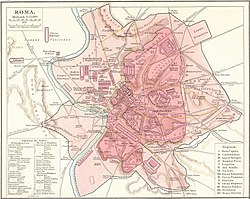Theater of Pompey

A 3D reconstruction of the Theatre of Pompey
|
|
| Location | Regione IX Circus Flaminius |
|---|---|
| Built in | 55 BC |
| Built by/for | Gnaeus Pompeius Magnus |
| Type of structure | Roman theatre |
| Related | Roman Republic, Mark Antony, Marcus Junius Brutus, Marcus Licinius Crassus, Assassination of Julius Caesar, Pompey, Cicero, First Triumvirate |
The Theatre of Pompey (Latin: Theatrum Pompeii, Italian: Teatro di Pompeo) was a structure in Ancient Rome built during the latter part of the Roman Republican era: completed in 55 BC. Enclosed by the large columned porticos was an expansive garden complex of fountains and statues. Along the stretch of the covered arcade were rooms dedicated to the exposition of art and other works collected by Pompey "the Great" (Gnaeus Pompeius Magnus) during his campaigns.
On the opposite end of the garden complex was a curia for political meetings. The senate would often use this building along with a number of temples and halls that satisfied the requirements for their formal meetings. The curia is infamous as the place where Julius Caesar was murdered by the Liberatores of the Roman Senate and elite.
The structure's last recorded repairs were carried out in AD 507–11. Following Rome's population decline during and after the Roman-Gothic wars of AD 535–54 there was no need for a large theatre. The marble covering material was used to maintain other buildings. Being located near the Tiber, the building was also regularly flooded, causing further damage. The building's concrete core remained standing in the 9th century. In the 11th century the ruins were converted into two churches and houses, with the theatre's old plan remaining visible. Around 1150 the powerful Orsini family bought all buildings on the site of the theatre and transformed them into a large fortress. Later in the Middle Ages the Campo de' Fiori square was built on top of the theatre's remains. Today, sections of the theatre are still extant, but they are buried under more modern edifices.
...
Wikipedia

